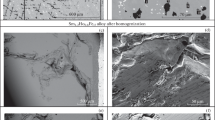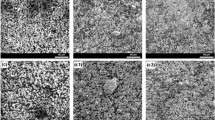Abstract
The effect of the wet milling time on the magnetic properties of powder compositions consisting of the hard magnetic Sm2Fe17N x (x = 2.9–3.0) nitride and a rapidly quenched Nd9.6Fe76.3Co4.3Zr3.4B6.4 (at %) alloy, which are taken in different mass proportions, is studied. The compositions containing no more than 20 wt % alloy are found to exhibit a substantial increase in the magnetic characteristics as compared to those of the nitride. It is shown that the determining effect on the coercivity is related to the degree of structural imperfection of Nd–Fe–B powders, whereas the specific remanent magnetization and the specific magnetization in a field of 2 T are determined by the corresponding characteristics of the alloy. The optimum composition and efficient treatment conditions for powder mixtures are determined.
Similar content being viewed by others
References
J. M. D. Coey and H. Sun, “Improved magnetic properties by treatment of iron-based rare earth intermetallic compounds in ammonia,” J. Mag. Mag. Mater. 87, L251–L254 (1990).
K. Schnitzke, L. Schultz, J. Wecker, and M. Katter, “High coercivity in Sm2Fe17Nx magnets,” Mater. Sci. Eng. A 133, 143–146 (1991).
K. Koyama and H. Fujii, “Nitrogen gas-solid reaction process and basic magnetism of the interstitially modified rare-earth 3d transition-metal nitrides R2Fe17N3 (R = Y, Ce, Nd, Sm) and Y2Co17N3,” Phys. Rev. B 61 (14), 9475 (2000).
O. Gutfleisch, “Controlling the properties of high energy density permanent magnetic materials by different processing routes,” J. Phys. D 33, R157–R172 (2000).
A. G. Savchenko and P. P. Pashkov, “Nanostructured rare-earth hard magnetic materilas,” in Gornyi Informatsionno- Analiticheckii Bulleten’, (Moscow, Izd. MGGU, 2007), Vol. 1, pp. 209–231.
M. Komuro, S. Kawamata, F. Tajima, and H. Koharagi, “Motor performance and magnetic properties of rotors with directly injected bonded magnets in laminated Fe–Si sheets,” J. Appl. Phys. 97, 10Q513 (2005).
S. Okada, K. Suzuki, E. Node, K. Takagi, K. Ozaki, and Y. Enokido, “Preparation of submicron-sized Sm2Fe17N3 fine powder with high coercivity by reduc-tion-diffusion process,” J. Alloys Comp. 695, 1617–1623 (2017).
A. G. Savchenko and V. P. Menushenkov, “Highenergy- product rare-earth permanent magnets: fundamental principles of development and manufacturing,” Phys. Met. Metallogr. 91, S242–S248 (2001).
Q. Fang, X. An, F. Wang, Y. Li, J. Du, W. Xia, A. Yan, J. Ping Liu, and J. Zhang, “The structure and magnetic properties of Sm–Fe–N powders prepared by ball milling at low temperature,” J. Mag. Mag. Mater. 410, 116–122 (2016).
G. Hadjipanayis, D. Neil, and A. Gabay, “Ultrafine Sm–Fe–N particles prepared by planetary ball milling,” EPJ Web of Conf. 40, 06006 (2013).
E. V. Shelekhov and T. A. Sviridova, “Software for X-ray analysis of polycrystals,” Metal Science and Heat Treatment 42, 309–313 (2000).
E. C. Stoner and E. P. Wohlfarth, “A mechanism of magnetic hysteresis in heterogeneous alloys,” Phil. Trans. Roy. Soc. A 240, 599–642 (1948). doi 10.1098/rsta.1948.0007
H. Chiriac, M. Marinescu, K. H. J. Buschow, R. F. de Boer, and E. Brück, “Influence of the annealing procedures on magnetic properties of α-Fe/Nd2Fe14B nanocrystalline alloys,” J. Mag. Mag. Mater. 202, 22–26 (1999).
W. Zhanyong, L. Wenqing, and S. Yanli, “Effects of magnetic annealing on crystallization and magnetic properties of Nd2Fe14B/α-Fe nanocomposite magnets,” J. Rare Earths 28, 417–419 (2010).
M. Yue, Y. Q. Li, R. M. Liu, W. Q. Liu, Z. H. Guo, and W. Li, “The structure and magnetic properties of Sm–Fe–N powders prepared by ball milling at low temperature,” J. Alloys Comp. 637, 297–300 (2015).
S. Zhang, L. Liu, J. Du, W. Xia, J. Zhang, Z. Guo, A. Yan, W. Li, and J. Ping Liu, “Sm2Fe17Nx nanoflakes prepared by surfactant assisted cryomilling,” J. Appl. Phys. 115, 17A1706 (2014).
Author information
Authors and Affiliations
Corresponding author
Additional information
Original Russian Text © A.G. Savchenko, V.P. Menushenkov, A.Yu. Plastinin, I.V. Shchetinin, I.G. Bordyuzhin, V.A. Ryazantsev, V.N. Verbetskii, E.A. Movlaev, 2017, published in Deformatsiya i Razrushenie Materialov, 2017, No. 9, pp. 30–34.
Rights and permissions
About this article
Cite this article
Savchenko, A.G., Menushenkov, V.P., Plastinin, A.Y. et al. Effect of the milling time on the magnetic properties of powder compositions of the Sm2Fe17N x intermetallic compound and an Nd–Fe–B alloy. Russ. Metall. 2017, 807–812 (2017). https://doi.org/10.1134/S0036029517100202
Received:
Published:
Issue Date:
DOI: https://doi.org/10.1134/S0036029517100202




